Don't wanna be here? Send us removal request.
Text
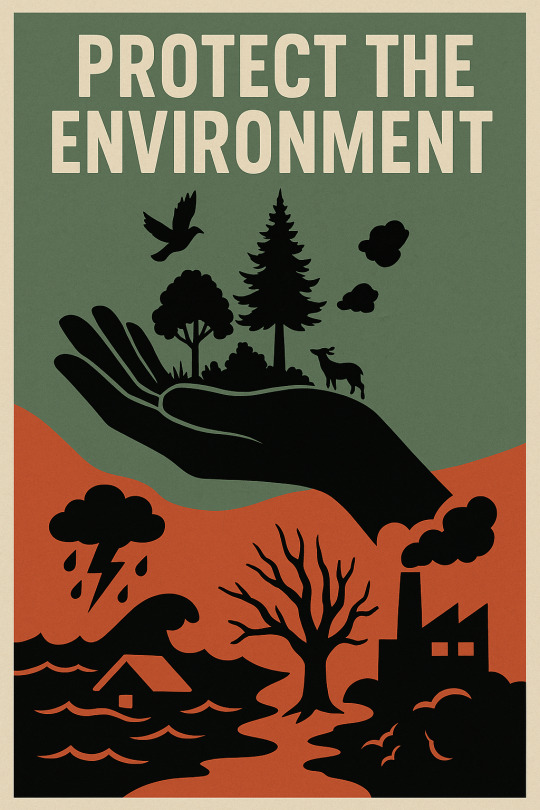
El Gamma Penumbra‘s Tribute to Mother Nature —Environmental Crisis Through Shadow Play
1. Summary of the Performance
El Gamma Penumbra’s shadow play delivers a moving and visually stunning message about the beauty of nature and the urgent need to protect it. Using only silhouettes and graceful movements, the group brings to life the wonders of the Earth—lush forests, diverse wildlife, and peaceful landscapes—before showing how pollution, deforestation, and climate change are destroying them. The performance reminds us that it’s our responsibility to care for the planet and preserve it for future generations.
2. Identify Environmental Themes
- Deforestation and Loss of Biodiversity: The performance shows trees being cut down and animals forced to flee, highlighting how human actions are destroying natural habitats.
- Pollution and Climate Change: Scenes of factories releasing smoke and disasters like typhoons and floods reflect the consequences of industrialization and environmental neglect.
3. Emotional Impact
The performance stirs deep emotions—sadness at the destruction, guilt over human responsibility, and a strong sense of urgency. Watching nature’s beauty fade into devastation through such expressive storytelling makes the environmental crisis feel personal. It leaves a lasting impression and a desire to do something about it.
4. Global Environmental Crisis
The themes in the performance mirror real-world problems like global warming, habitat loss, and the overuse of natural resources we’ve learned about environmental degradation and reminds us that these issues are not far away—they’re happening all around us, right now.
5. Role of Art and Culture
Art has a unique way of reaching people. Unlike facts and figures, performances like this speak to the heart. They can raise awareness, spark conversations, and inspire action. El Gamma Penumbra shows how creativity and culture can be powerful tools in the fight for environmental protection.
6. Local Connections
In the Philippines, we face many of the same issues shown in the performance—illegal logging, frequent typhoons, and poor waste management. The shadow play reflects our own struggles and encourages us to think about how we can address these problems in our communities.
7. Personal or Collective Action
After watching the performance, it’s hard not to feel motivated to help. On a personal level, we can reduce waste, plant trees, and join clean-up drives. As a community, we can support environmental education, push for stronger environmental laws, and promote sustainable habits. Every small step counts.
0 notes
Text

McDonald’s and Jollibee
McDonald’s and Jollibee are two of the most iconic fast-food giants in the world and the Philippines, respectively. McDonald’s, founded in 1940 in California, USA, is known globally for its golden arches, hamburgers, and consistent customer experience across more than 100 countries. It pioneered the fast-food concept with quick service, standardized menus, and international expansion.
On the other hand, Jollibee, founded in 1978 in the Philippines, has grown into a beloved homegrown brand that resonates deeply with Filipino taste and culture. Known for its sweet-style spaghetti, crispy chicken joy, and smiling bee mascot, Jollibee has become a symbol of Filipino pride, expanding to overseas markets to serve both local and global customers.
While McDonald’s represents the American fast-food empire, Jollibee reflects the heart of Filipino comfort food making their rivalry and coexistence a unique example of global vs. local success in the fast-food industry.
McDonald's History Timeline
1940s – The Beginning
1940 – Richard and Maurice McDonald open the first McDonald's Bar-B-Q restaurant in San Bernardino, California.
1948 – They streamline the menu and service to burgers, fries, and drinks using the “Speedee Service System,” a prototype for fast food.
1950s – Birth of the Franchise
1954 – Ray Kroc, a milkshake machine salesman, discovers the McDonald brothers' restaurant.
1955 – Kroc opens the first McDonald's franchise in Des Plaines, Illinois, and forms McDonald's Corporation.
1958 – McDonald's sells its 100 millionth hamburger.
1960s – Rapid Growth
1961 – Kroc buys exclusive rights to the McDonald’s name for $2.7 million.
1963 – McDonald’s opens its 500th restaurant; introduces Ronald McDonald
1965 – McDonald's goes public on the stock market.
1967 – First international outlets open in Canada and Puerto Rico.
1970s – Global Expansion
1971 – McDonald’s opens in Japan, Germany, and Australia.
1975 – First Drive-Thru opens in Arizona.
1979 – Launch of Happy Meal.
1980s – Branding & Innovation
1984 – Ray Kroc dies; McDonald’s has over 7,500 restaurants in 32 countries.
1986 – The “McDonald’s Index” is created by The Economist.
1988 – McDonald's opens in 88 countries.
1990s – Political & Cultural Icon
1990 – First restaurant opens in Moscow, Russia.
1993 – Launch of McCafé in Australia.
1996 – Enters India with a menu adapted to local tastes.
2000s – Health & Sustainability
2003 – Launch of “I’m Lovin’ It” campaign.
2004 – Featured in the documentary “Super Size Me”, which triggers menu changes.
2005 – Introduces salads and healthier options.
2010s – Digital and Delivery Era
2015 – Launches All-Day Breakfast in the U.S.
2017 – Rolls out self-service kiosks.
2019 – Acquires AI tech companies to personalize menus.
2020s – Tech and Transformation
2020 – Expands delivery services and mobile ordering amid COVID-19.
2021 – Launches “Famous Orders” campaigns (e.g., Travis Scott, BTS).
2023 – Focus on sustainability, plant-based options like McPlant, and expansion of automated drive-thrus.
McDonald's Today
Over 40,000 restaurants in 100+ countries. Continues evolving with tech innovations, sustainable practices, and global marketing.
Jollibee History Timeline
1970s – The Sweet Beginning
1975 – Tony Tan Caktiong and family open a small ice cream parlor in Quezon City, Philippines.
1977 – Due to customer demand, they add hot meals and sandwiches to the menu.
1978 – The name "Jollibee" is born. The first official Jollibee store opens.
Jollibee Foods Corporation (JFC) is established.
Bee mascot symbolizes happiness and hard work.
1980s – The Filipino Fast-Food Giant
1981 – Opens the first franchise store.
1984 – Opens first international branch in Taiwan.
1987 – Launches Jollibee Kids Meal.
1988 – Wins Market Leader vs. McDonald's in the Philippines.
1990s – Expansion and Innovation
1993 – Jollibee goes public; listed on the Philippine Stock Exchange.
1995 – Enters United Arab Emirates and Saudi Arabia.
1998 – Acquires Greenwich Pizza.
1999 – Launch of Jollitown TV show concept begins to form.
2000s – Going Global
2001 – Acquires Chowking and Red Ribbon.
2004 – Opens in California, USA.
2005 – Expands to Hong Kong.
2007 – Launches the children’s show “Jollitown” on GMA Network.
2010s – Acquisitions and Global Push
2011 – Opens 700th store in the Philippines.
2013 – Enters Singapore and Kuwait.
2015 – Opens in Canada; long lines of Filipino communities.
2018 – Acquires 80% of Smashburger (USA).
2019 – Opens first UK store in London.
2020s – Resilience and Innovation
2020 – Adapts to COVID-19 with stronger delivery, take-out, and digital services.
2021 – Expands mobile app and cloud kitchens.
2022 – Enters Spain and more European markets.
2023 – Reaches over 1,500 stores worldwide.
Jollibee Today
Operates in 33+ countries with 1,600+ stores globally. Recognized for iconic products like Chickenjoy, Jolly Spaghetti, and Yumburger. Symbol of Filipino pride, serving both locals and OFWs worldwide.
0 notes
Text

Family Planning, Overpopulation & Environmental Disaster
1.) Summarize the Message
The Family Planning TV Commercial 2014 delivers a strong message that is essential for every family. Family planning is important to build healthy families, empowered individuals, and stronger communities. It emphasizes the importance of and the right to make informed reproductive choices and promote access to contraceptives and education. The commercial highlights that proper birth control can benefit maternal and child health and empower young people, especially young women, to pursue their education. By this, the family could prevent poverty by being able to manage resources.
2.) Identify Key Issues
The Family Planning TV commercial shows the negative effects of overpopulation and the lack of family planning on some main issues, including poverty and the environment. Lack of basic resources, such as food, water, and land, could result in both a declining standard of living and an unhealthy environment. Particularly among young people, unplanned pregnancies lead to poverty, making it more difficult to access essential resources like healthcare, education, and basic necessities. This will also affect future living, as their children would not be able to experience education.
3. Explain Overpopulation's Impact
Overpopulation contributes to major environmental issues like flooding, deforestation, and pollution. While population is increasing, more land is cleared for building houses and infrastructure, they clear the forest and cut the trees to expand building areas. Because of this, land's ability to absorb rainwater would decrease, which leads to floods. While population increases, technology increases too. For instance, as years have passed, people have bought cars that cause air pollution.
4. Describe Urban Challenges
The consequences of unplanned population growth, which is clearly reflected in some city in Philippines like Manila. Overpopulation in these urban areas places immense strain on essential resources and infrastructure, such as housing, transportation, water supply, and healthcare. As more people move into cities, overcrowded communities face shortages in clean water, poor sanitation, traffic congestion, and overwhelmed hospitals and schools.
5. Discuss Family Planning Role
Family planning contributes by letting individuals and couples know the importance of knowledge about when and how many children to have. By assessing the importance of contraceptives and reproductive health education, family planning prevents unintended pregnancies, and it would encourage proper birth spacing. This would help to prevent individuals, especially couples, from constant pregnancy. This would also lead to slower population growth, which would lessen the demand for land, water, and food. As a result, there would be less deforestation, pollution, and pressure on natural resources.
6. Analyze Government Responsibility
To promote effective family planning and manage population growth to lessen environmental risk, the government needs to conduct some programs or projects that will mainly tackle the importance of letting the community know the impact of overpopulation growth on society and its impact on the environment. Also, they should discuss sex education formally for the community to be able to understand the downside of overpopulation.
7. Research and Reflect
One of the recent environmental disasters in the Philippines was the 2020 Typhoon Ulysses that caused severe flooding in Metro Manila. The effect of the disaster was worsened due to overpopulation density and poor urban planning. Many poor or low-income families live in overcrowded, built homes beside rivers, canals, and flood-prone areas due to the lack of affordable housing.
0 notes
Text
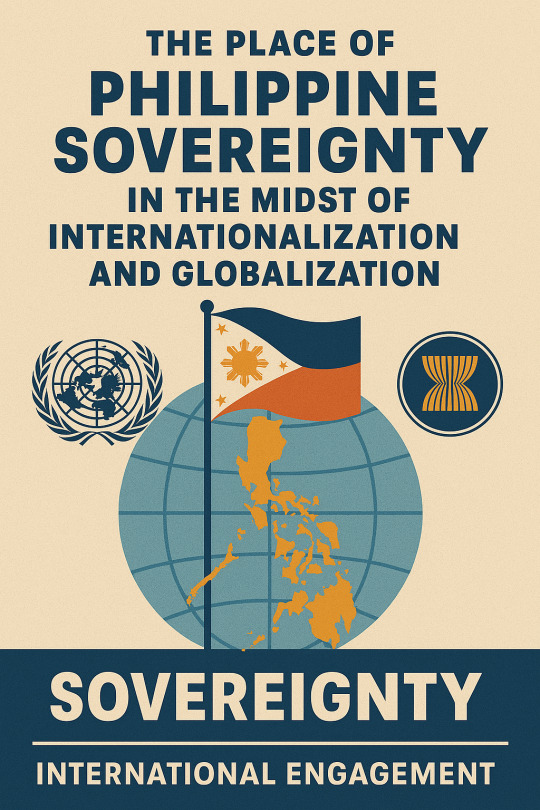
The Place of Philippine Sovereignties in the Midst of Internationalizations and Globalizations
Sovereignties refer to nations’ full rights and authorities to govern themselves without interference from external forces. Internationalizations are processes where nations engage in increased cooperation, exchanges, and collaborations across borders. Globalizations, however, are broader—they involve the integrations of economies, cultures, politics, and technologies worldwide, creating interdependences among nations.
The rises of interstate systems transformed how countries interact. Before these, kingdoms and empires dominated. The Treaties of Westphalia in 1648 marked turning points by establishing the ideas that each nation-state has sovereignty over their own territories. These paved the ways for modern diplomacies. Later, organizations like the Leagues of Nations and the United Nations (UN) further formalized international relations, promoting peace, cooperations, and shared responsibilities among nations.
For the Philippines, involvements in global and international systems have both benefits and challenges. They gain access to global markets, foreign aids, advanced technologies, and international supports during crises. The presences of OFWs and multinational corporations fuel economies and foster cultural exchanges. However, overreliances on foreign investments, trade imbalances, and territorial disputes (like those in the West Philippine Sea) can threaten national sovere pressures from more powerful countries may influence domestic decisions on trade, defense, and policies.
Whether international engagements strengthen or weaken Philippine sovereignties depend on how they are managed. Strong institutions, independent policymakings, and national unities are essential in preserving autonomies while participating globally.
Personally, we believe that the Philippines should embrace globalizations without compromising their core national interests. We must protect local industries, invest in educations and innovations, and build self-reliant economies. Active participations in regional and global affairs—such as ASEAN and the UN—should be used as tools to promote national developments while safeguarding sovereignties.
Sovereignties today do not mean isolations. They mean being smart and strategic—engaging globally, but always putting the Filipino peoples and our nation's futures first.
Reference:
Osiander, A. (2001). Sovereignty, international relations, and the Westphalian myth. International Organization, 55(2), 251–287. https://doi.org/10.1162/00208180151140577
United Nations. (1945). Charter of the United Nations. https://www.un.org/en/about-us/un-charter
Permanent Court of Arbitration. (2016). The South China Sea Arbitration (The Republic of the Philippines v. The People’s Republic of China) (PCA Case No. 2013–19). https://pca-cpa.org/en/cases/7/
World Health Organization. (2021). COVAX: Ensuring global equitable access to COVID-19 vaccines. https://www.who.int/initiatives/act-accelerator/covax
ASEAN Secretariat. (2020). Regional Comprehensive Economic Partnership (RCEP) Agreement. https://asean.org/rcep-agreement/
Bangko Sentral ng Pilipinas. (2024). Overseas Filipino cash remittances. https://www.bsp.gov.ph/Statistics/External/Pages/OFRemittances.aspx
0 notes
Text

Understanding the Global City
In many cities, street vendors, tricycle drivers, and informal settlers might view a cartoon like this as a mirror of their everyday realities. The towering malls and office buildings represent wealth and power, while they struggle on the fringes—often unseen, often unheard. For them, it could feel like the cartoon quietly tells the story of how the city grows, but leaves them behind.
They might connect it to rising prices, the lack of secure jobs, and being pushed out of public spaces where they try to make a living. Despite being vital to the rhythm and character of city life, they’re treated as if they don’t belong. The image might feel like a cry for fairness—asking for better city planning, safer workspaces, and true recognition for the work they do.
Even as global cities expand through booming industries, tech, and tourism, the wealth isn’t shared equally. Well-paying jobs often go to those with education and influence, while low-skilled workers face long hours, low wages, and no job security. Housing becomes more expensive, pushing everyday people into overcrowded settlements with poor living conditions, government investments tend to favor flashy infrastructure for tourists and big businesses, while poor neighborhoods get left behind—without decent hospitals, schools, or transport. Wealthy investors buy up prime land, driving prices even higher and pushing the poor out of their communities.
And even with job opportunities, workers in essential sectors like food delivery, street vending, or local transport still face harsh conditions and little protection. Social services can’t keep up with the fast urban growth, and those who are already marginalized often face even more barriers from lack of inclusive policies.
In the end, economic growth doesn’t automatically mean equality. Without systems that intentionally support and uplift those at the margins, the gap between rich and poor just keeps growing—leaving the city to thrive, but only for a few.
Reference:
Microsoft Copilot. (2025). Editorial cartoon on urban inequality and informal workers. Generated image.
0 notes
Text
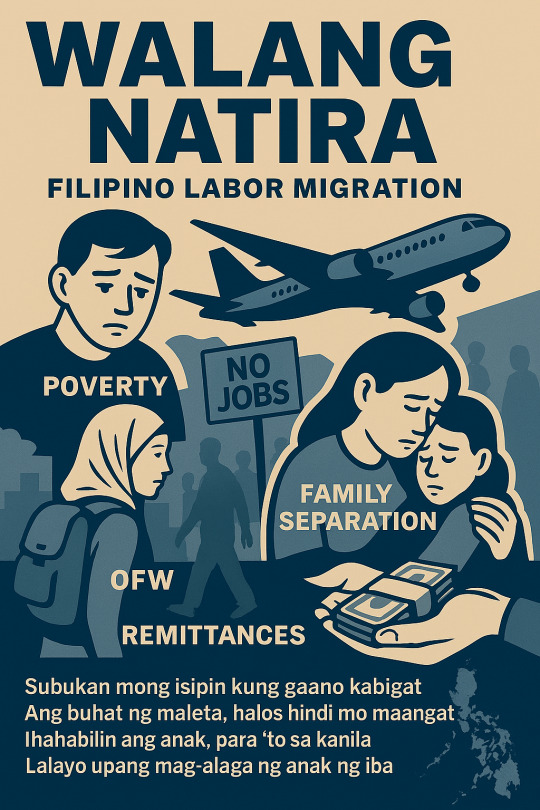
"Walang Natira" by Gloc-9—Migration and its Effects.
1. Summarize the Song's Message
Gloc-9’s “Walang Natira” talks about the quiet but painful reality of many Overseas Filipino Workers (OFWs). The song tells the story of those who leave the country not because they want to, but because they need to—for the sake of their family’s future. It shows the heartbreak of being away from loved ones and the big problems at home that force people to work far away.
2. Identify Reasons for Migration
The song explains that many Filipinos are pushed to work abroad because of poverty, unemployment, and low wages. There are simply not enough decent-paying jobs in the country. For many, working overseas becomes the only way to keep their families stable, even if it means leaving everything familiar behind.
3. Discuss Effects on Families
One of the most painful parts of migration is the impact on families. Parents miss out on their children’s childhood, and partners are separated for years. While money is sent home, emotional needs are often left behind. The song reminds us that love and presence can’t be replaced by remittances.
4. Analyze Economic Impact
According to the song, OFWs are a huge support to the national economy. The money they send home helps their families and strengthens the country’s finances. But the song also questions why so many Filipinos feel they must leave just to survive—showing that the economic system at home isn’t giving people the opportunities they deserve.
5. Connect to Global Migration
“Walang Natira” also speaks to a wider global story. Around the world, people from less wealthy countries migrate to earn a living and support their families. The song helps us see that Filipinos aren't alone in this struggle—many people across the globe face the same hard choice between staying with their loved ones or providing for them from afar.
6. Reflect on Social Issues
Gloc-9’s lyrics touch on serious problems that lead to migration—like poverty, joblessness, broken families, and the loss of skilled workers. These issues don’t just affect individuals—they spread through society, weakening the very communities left behind.
7. Personal or Community Response
Despite the hardships, the song encourages hope and unity. We can show support for OFWs by staying emotionally connected, advocating for better local job opportunities, and building stronger communities. Whether in the Philippines or abroad, Filipinos can lift one another up, form support groups, and work toward a future where migration becomes a choice—not the only option left.
0 notes
Text
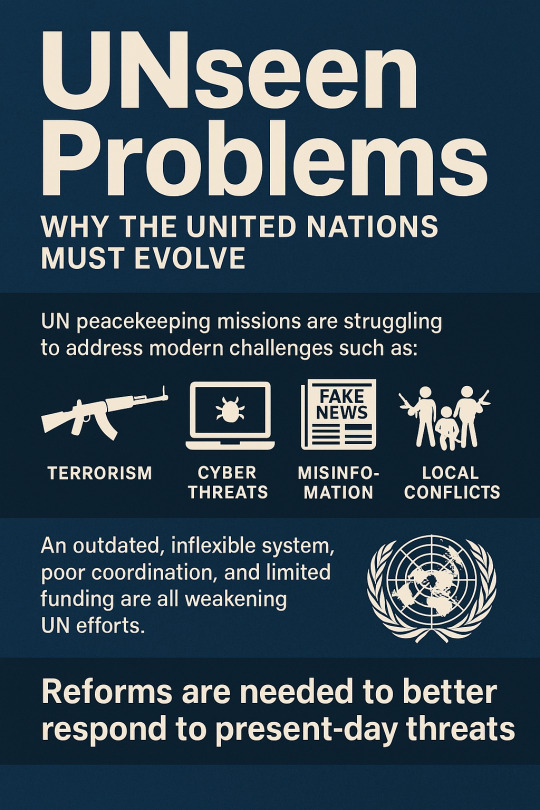
“UNseen Problems: Why the United Nations Must Evolve”
The video “UN Peace Ops must evolve to face modern threats” highlights how United Nations peacekeeping missions are falling behind in a fast-changing world. These missions were originally designed to stop wars between countries, but today’s conflicts look very different. Peacekeepers now face challenges like terrorism, cyberattacks, fake news, and clashes involving armed groups—not just nation-states.
Experts say the UN’s system isn’t built for these new realities. It struggles with slow coordination between different agencies, outdated approaches, and not enough funding—making it tough to react quickly during crises. That’s why the UN is working on major reforms to make peacekeeping more flexible, modern, and ready for today’s threats.
This global issue mirrors what we experience in the Philippines. Many barangays and local government units (LGUs) are also using systems that don’t reflect the digital age. From online scams and cyberbullying to misinformation spreading faster than ever, our communities are under pressure. Coordination between agencies is sometimes slow, and limited budgets or training only add to the delay in response.
Both the UN and our local governments face the same truth: if we want to solve modern problems, we need modern solutions. That means updating tools, improving teamwork, and investing in systems that protect people better—globally and locally.
youtube
1 note
·
View note
Text
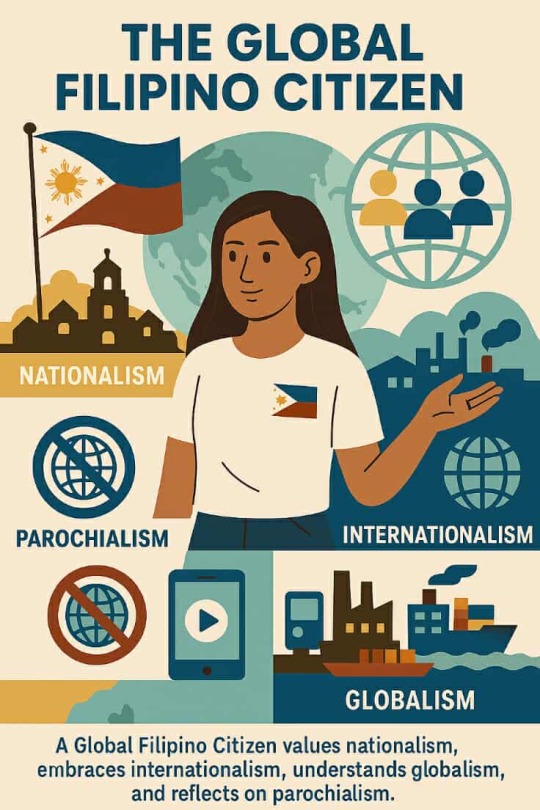
Embracing My Identity as a Global Filipino Citizen
Introduction
In today's interconnected world, being a Filipino is more than just holding a Philippine passport or speaking the national language. It also means knowing how to contribute meaningfully to a global society while staying rooted in one's national identity. A Global Filipino Citizen is someone who understands and practices the values of nationalism, internationalism, globalism, and consciously reflects on the challenges of parochialism. These four concepts shape how we, as Filipino students, can find our place and purpose both in our country and in the world.
Nationalism plays a central role in forming a Global Filipino Citizen. It is the deep sense of pride, love, and loyalty to our country. It goes beyond merely waving the flag or singing the national anthem; it is about embracing our cultural heritage, promoting our local industries, and protecting our national interests. As a student, we show nationalism by using and promoting Filipino-made products, studying our history with sincerity, and speaking our language with pride. This sense of national identity gives us a firm foundation when interacting with other cultures, allowing us to represent the Philippines with confidence and integrity. On the other hand, internationalism encourages solidarity and cooperation among nations. It is about seeing humanity as a shared community and supporting global causes such as climate action, peace, and education. As a Filipino student, we can practice internationalism by participating in international forums, collaborating with students from other countries through online platforms, and staying informed about global events. For example, joining the model United Nations or contributing to social media campaigns for international awareness allows us to exercise this principle. Internationalism teaches us to respect differences and to view others not as strangers, but as fellow citizens of the world. Globalism refers to the growing interconnectedness of nations in terms of economics, politics, technology, and culture. It emphasizes global interdependence and the importance of engaging in the global economy. Overseas Filipino Workers (OFWs) are living examples of globalism they contribute to foreign economies while supporting families back home. As a student, we engage with globalism when we use global technology, follow international trends, and prepare ourselves for careers that may involve working with diverse people or in multinational companies. Understanding globalism motivates us to study harder so we can be globally competitive while still promoting Filipino values. In contrast, parochialism is a limited worldview that focuses only on local interests, often ignoring the broader global context. It can hinder growth and development by resisting change and diversity. While love for one's local community is important, being overly parochial may lead to close-mindedness. As a student, we challenge parochial thinking by being open to new ideas, listening to diverse perspectives, and being willing to collaborate with people from different backgrounds. We believe that true patriotism is not about rejecting the foreign, but about learning from it while improving our local systems.
Conclusion
In conclusion, nationalism, internationalism, globalism, and parochialism are not isolated concepts they are interconnected forces that help define what it means to be a Global Filipino Citizen. As a student, we must balance pride in our identity with openness to the world, ensuring we do not fall into narrow or outdated views. These values guide us as we grow into someone who can serve the Philippines and the global community at the same time.
Reflection
As a student, we can practice being a Global Filipino Citizen by embracing our Filipino identity while staying open to global perspectives. We can support local efforts such as community clean-ups or cultural events while also engaging in global conversations about climate change, human rights, and innovation. By being both proud of our roots and open to change, we believe we can help shape a better Philippines and a more united world.
References (APA style)
Anderson, B. (2006). Imagined communities: Reflections on the origin and spread of nationalism (Rev. ed.). Verso Books.
Heywood, A. (2011). Global politics. Palgrave Macmillan.
Scholte, J. A. (2005). Globalization: A critical introduction (2nd ed.). Palgrave Macmillan.
United Nations. (n.d.). Global citizenship education. Retrieved from https://www.un.org/en/global-issues/education
Oxford Reference. (n.d.). Parochialism. Retrieved from https://www.oxfordreference.com/
1 note
·
View note